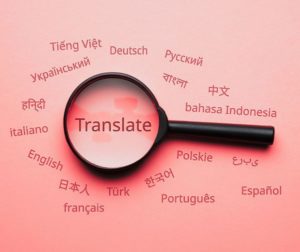I once read somewhere that translating is like assembling a machine just like the original, but with different parts.
If you think that for every word in the source language you only have to look up the equivalent word in your native language, you better think twice. At some point in the process—sooner than later—you will realize that the pieces of your puzzle are different, but that with them you will have to put together an equivalent puzzle. 🧩 🧩
Those who work in translation, whether providing technical translation services or creative translation services, for example, know all too well how challenging this work can be. This cannot be said for the general public, who lacks specific knowledge and usually has oversimplistic notions of translation.
You won’t even have to try to translate artistic or fictional languages like Klingon, High Valyrian, Na’vi, Dothraki, Chakobsa, or Sardaukar to find words and expressions that have no equivalent in your language! 🍄 🐉
Especially when it comes to language pairs that have no proximity or similarities between them. It’s common for translators to come across pieces of the puzzle in the source language that don’t exist in their native language.

When there’s no direct translation, you have to find a phrase or explanation to replace a single word, and it has to sound natural, you see? It’s that complex!
There are several other linguistic, lexical, syntactic, and textual factors that affect the translation process, but interlinguistic differences present the most difficulty.
Some words have meanings that, figuratively, may be contrary to their actual definitions in the dictionary.
For example, in English, “sick” means diseased but, if used figuratively, as in the expression “That’s sick!” it can refer to something really bad, or it can refer to something awesome! Only the tone of voice and facial expression, which we don’t have in written language, or the context, can tell us which of the two opposite meanings was intended.
Did you know that in some countries people have 20 fingers, while in other countries they only have 10? 🤔

If we ask Portuguese, Spanish, Russian or even Japanese children how many fingers they have, they will answer they have 20.
But ask English or German children how many fingers they have, and they will surely answer they have 10! 🖐🏻
This is because some languages consider fingers and toes to be equal body parts that don’t need to be named differently: finger and toe in English or finger and zehen in German are both translated into Portuguese as “dedos.” In our case, we distinguish both by adding: “dedos das mãos” and “dedos dos pés” (fingers on the hands, fingers on the feet).
If someone tried to translate a sentence about a teacher touching a student on the back with his finger from Portuguese into English, without any knowledge and relying only on a dictionary, the term “toe” could also come up for “dedo,” but in English it would mean the teacher had touched the student on the back… with his toe! 🦶🏻

Cringe worthy to say the least…!
Most frequent difficulties in translation
- Idioms, figurative meaning and slang
- Translating different language structures
- Words that don’t exist in the target language
- Words with multiple meanings
- Compound word translation
- Translating two-word verbs
- Lists of terms or expressions without context
- Translation of irony and sarcasm
- Translation of humorous texts, jokes
- Poetry translations…
The translation process is complex ⚙️ 👷

While two decades ago terminological research was mostly conducted on paper—in dictionaries, same field texts, technical books, etc.—nowadays everything happens mostly on the Internet, an almost unlimited resource that is a mandatory work instrument for professional translators.
Translation work is mostly conducted in search engines such as Google, Bing, Ask, Yahoo or Duck Duck Go, but technical translation professionals also use terminology databases such as IATE, Proz or EUR-Lex.
Still, especially in technical translations, a physical library of reference works in specific technical fields is still an asset.
This goes to show that having skills in one language or even in both the source and target languages is not enough to produce a good translation. Translation is a complex process that involves multiple skills and sub-skills.

Along with research skills, a fundamental sub-skill is the ability to “filter” the search results—not everything that emerges in a search is useful or true, so one must know how to distinguish the wheat from the chaff.
Textual competences also include essential sub-skills like text analysis and interpretation, not to mention text production. It’s not enough that the original text is well written—you must be good at writing in your target language as well. Translators must have good writing skills themselves to produce a quality text in their native language.
In addition, translation always requires good cultural knowledge of both countries, since the translator must be able to produce a translation that works in the target language just as it did in the source language. This wouldn’t be possible without the competence to adapt the text to the reality experienced by the target audience.

One of the most common challenges is polysemy
Polysemy, from the Greek polis (“many”) and sema (“meaning”), refers to the existence of multiple valid meanings for the same word. 🏺
By choosing a direct translation you risk missing the mark and ending up with a mistranslation. Sometimes we get the right meaning from the context. Other times, even considering context, the meaning is ambiguous. And sometimes we translate lists of loose words without any context to our credit.
For example, the word “date” can refer to “the day, month and year” 🗓️, a “fruit that grows on palm trees” 🌴, or a “romantic meeting between two people.” 💑
“False friends” are not your next-door neighbors! 😬
.Joking aside, this expression refers to the difficulty that arises in mastering a lexicon when there’s a false similarity between words in one language and the other, which can lead to error.

False cognates or “false friends” are words that look or sound similar in two different languages but have different origins and meanings.
The misunderstanding created will be more or less serious depending on how distant their meanings are from one another.
One example is the term “decepção,” which sounds similar to the English word “deception” meaning “illusion” or “fraud,” while the Portuguese word means “disappointment.”
Portuguese and Spanish have a legion of false friends between them. Many Portuguese people think they can speak “Spanish” easily due to the similarity of so many words but end up speaking a concoction of both languages that, to the Spanish, is unintelligible.
All that glitters is not gold. For example, “grão” (chickpea) is not the same as “grano,” though they sound very similar. Chickpea in Spanish is in fact “garbanzo,” which couldn’t be farther from “grão.” The Spanish word grano means grain, as in a grain of sand or cereal.
Another example would be “apenas.” In Portuguese this means “only,” while in the neighboring country apenas means “as soon as.”
In fact, they are both Latin languages and there’s a proximity, not only geographically, but they are not as similar as people think—and besides false friends there are also many grammatical differences, and verb conjugation is also different.
Check out this very extensive list of false friends for a better understanding of this issue:
https://ec.europa.eu/translation/portuguese/magazine/documents/folha47_lista_pt.pdf
The ambiguities in language are multiple and diverse
They can be lexical, thematic, structural, analytical… Lexical ambiguities are rooted in polysemy, homonymy, etc. From a syntactic point of view, we have various possibilities for grouping the constituents of a sentence, where different alternatives of grouping or combinations may result in ambiguous sentences. These ambiguities are structural.
-
“Ivy left school on the wrong bus.”
From grammar alone, this could have two meanings. School was on the wrong bus and Ivy left it there. We need our knowledge of the world to determine that a school could not be on the bus, so Ivy came home on the wrong bus and the school, of course, stayed put.
-
“The examiner seemed nice to me.”
You could say that, in your opinion, he is a good person in general, he looked like a nice man. But you could also be saying he was nice to you alone, which doesn’t mean that he seemed like a good person in general, he could be a horrible person! In this case, it’s harder to determine which of the two interpretations would be correct, at least without further context.
-
“The child is ready to eat.”
It clearly means that the child is ready to start eating. However, if you just replaced the noun and say that “The chicken is ready to eat” it could mean that it’s time to go feed our chicken. Grammatically speaking, we can also have a roasted chicken in the oven, ready to be eaten.
In the first case, referring to a child, there’s no ambiguity, so it’s not just the words and the grammar that allow us to determine that the child is not food, but also our good sense and our knowledge of the world.
However, the theme is also of interest in determining ambiguity, because if we were translating a book about cannibalism, the interpretation of the first sentence would no longer be obvious!
-
“A man was lying with his face to the wall.”
In Portuguese, a “wall” can refer to the interior walls (paredes) of a building, or a brick or stone enclosure that divides an area of land out in the open (muro). Without a picture or context that would allow us to interpret, how would we know if the man was in the house facing the bedroom wall (parede) or outside facing a wall (muro)?
Your experience might tell you that it’s more likely for a human being to be lying down inside than in the middle of the street… But if we think about it, an outdoor scenario isn’t impossible, as the man could also be a homeless person sleeping outside.
-
“Sit Down.”
There are also pragmatic ambiguities. If the context doesn’t guide us, a simple “sit down” can be a request or an order, depending on the tone and facial expression of the person speaking. But these are features we don’t have in a written text.
Language itself is full of subtleties that cannot be fully understood just by knowing the words.
Ambiguity can be intended or incidental.
If the author of a text uses ambiguity on purpose, it’s up to the translator to figure out how to maintain it in the translation.
Nonetheless, this will not be an easy task, unless the author uses words with only one translation in the target language instead of words with a double or triple meaning in the source language—if that’s the case, translators will have their work cut out for them!

The conclusion is obvious—defining translation as a process of transferring words or written text from one language into a different language is extremely reductive.
Therefore, a translator must have:
- linguistic abilities
- investigatory abilities
- textual abilities
- technical abilities
- cultural abilities
These are inextricably linked to problem-solving skills because translators must be able to think strategically and escape their mental routines in order to face the translation challenges they meet all the time. It’s essential to acquire automatisms to identify and respond to these challenges, since they are unavoidable and more frequent than you might think.
Translating isn’t just about transferring lexical and grammatical content between two languages, because the meaning of the text isn’t only in the grammar and lexicon.
Meaning depends on our interpretation of the text, using the reader’s or translator’s personal knowledge—far beyond linguistic knowledge. The multiple meanings of each word must be chosen or decided by the translator depending on the context, the internal content has to be related to external content, and comprehension is subject to various points of view that may not even be personal but cultural.
Be sure to come back for our next post, which stems from these complexities of human language to analyze the consequences of translation errors. Follow us on social media and/or subscribe to our newsletter here.
I once read somewhere that translating is like assembling a machine just like the original, but with different parts.
If you think that for every word in the source language you only have to look up the equivalent word in your native language, you better think twice. At some point in the process—sooner than later—you will realize that the pieces of your puzzle are different, but that with them you will have to put together an equivalent puzzle. 🧩 🧩
Those who work in translation, whether providing technical translation services or creative translation services, for example, know all too well how challenging this work can be. This cannot be said for the general public, who lacks specific knowledge and usually has oversimplistic notions of translation.
You won’t even have to try to translate artistic or fictional languages like Klingon, High Valyrian, Na’vi, Dothraki, Chakobsa, or Sardaukar to find words and expressions that have no equivalent in your language! 🍄 🐉
Especially when it comes to language pairs that have no proximity or similarities between them. It’s common for translators to come across pieces of the puzzle in the source language that don’t exist in their native language.

When there’s no direct translation, you have to find a phrase or explanation to replace a single word, and it has to sound natural, you see? It’s that complex!
There are several other linguistic, lexical, syntactic, and textual factors that affect the translation process, but interlinguistic differences present the most difficulty.
Some words have meanings that, figuratively, may be contrary to their actual definitions in the dictionary.
For example, in English, “sick” means diseased but, if used figuratively, as in the expression “That’s sick!” it can refer to something really bad, or it can refer to something awesome! Only the tone of voice and facial expression, which we don’t have in written language, or the context, can tell us which of the two opposite meanings was intended.
Did you know that in some countries people have 20 fingers, while in other countries they only have 10? 🤔

If we ask Portuguese, Spanish, Russian or even Japanese children how many fingers they have, they will answer they have 20.
But ask English or German children how many fingers they have, and they will surely answer they have 10! 🖐🏻
This is because some languages consider fingers and toes to be equal body parts that don’t need to be named differently: finger and toe in English or finger and zehen in German are both translated into Portuguese as “dedos.” In our case, we distinguish both by adding: “dedos das mãos” and “dedos dos pés” (fingers on the hands, fingers on the feet).
If someone tried to translate a sentence about a teacher touching a student on the back with his finger from Portuguese into English, without any knowledge and relying only on a dictionary, the term “toe” could also come up for “dedo,” but in English it would mean the teacher had touched the student on the back… with his toe! 🦶🏻

Cringe worthy to say the least…!
Most frequent difficulties in translation
- Idioms, figurative meaning and slang
- Translating different language structures
- Words that don’t exist in the target language
- Words with multiple meanings
- Compound word translation
- Translating two-word verbs
- Lists of terms or expressions without context
- Translation of irony and sarcasm
- Translation of humorous texts, jokes
- Poetry translations…
The translation process is complex ⚙️ 👷

While two decades ago terminological research was mostly conducted on paper—in dictionaries, same field texts, technical books, etc.—nowadays everything happens mostly on the Internet, an almost unlimited resource that is a mandatory work instrument for professional translators.
Translation work is mostly conducted in search engines such as Google, Bing, Ask, Yahoo or Duck Duck Go, but technical translation professionals also use terminology databases such as IATE, Proz or EUR-Lex.
Still, especially in technical translations, a physical library of reference works in specific technical fields is still an asset.
This goes to show that having skills in one language or even in both the source and target languages is not enough to produce a good translation. Translation is a complex process that involves multiple skills and sub-skills.

Along with research skills, a fundamental sub-skill is the ability to “filter” the search results—not everything that emerges in a search is useful or true, so one must know how to distinguish the wheat from the chaff.
Textual competences also include essential sub-skills like text analysis and interpretation, not to mention text production. It’s not enough that the original text is well written—you must be good at writing in your target language as well. Translators must have good writing skills themselves to produce a quality text in their native language.
In addition, translation always requires good cultural knowledge of both countries, since the translator must be able to produce a translation that works in the target language just as it did in the source language. This wouldn’t be possible without the competence to adapt the text to the reality experienced by the target audience.

One of the most common challenges is polysemy
Polysemy, from the Greek polis (“many”) and sema (“meaning”), refers to the existence of multiple valid meanings for the same word. 🏺
By choosing a direct translation you risk missing the mark and ending up with a mistranslation. Sometimes we get the right meaning from the context. Other times, even considering context, the meaning is ambiguous. And sometimes we translate lists of loose words without any context to our credit.
For example, the word “date” can refer to “the day, month and year” 🗓️, a “fruit that grows on palm trees” 🌴, or a “romantic meeting between two people.” 💑
“False friends” are not your next-door neighbors! 😬
.Joking aside, this expression refers to the difficulty that arises in mastering a lexicon when there’s a false similarity between words in one language and the other, which can lead to error.

False cognates or “false friends” are words that look or sound similar in two different languages but have different origins and meanings.
The misunderstanding created will be more or less serious depending on how distant their meanings are from one another.
One example is the term “decepção,” which sounds similar to the English word “deception” meaning “illusion” or “fraud,” while the Portuguese word means “disappointment.”
Portuguese and Spanish have a legion of false friends between them. Many Portuguese people think they can speak “Spanish” easily due to the similarity of so many words but end up speaking a concoction of both languages that, to the Spanish, is unintelligible.
All that glitters is not gold. For example, “grão” (chickpea) is not the same as “grano,” though they sound very similar. Chickpea in Spanish is in fact “garbanzo,” which couldn’t be farther from “grão.” The Spanish word grano means grain, as in a grain of sand or cereal.
Another example would be “apenas.” In Portuguese this means “only,” while in the neighboring country apenas means “as soon as.”
In fact, they are both Latin languages and there’s a proximity, not only geographically, but they are not as similar as people think—and besides false friends there are also many grammatical differences, and verb conjugation is also different.
Check out this very extensive list of false friends for a better understanding of this issue:
https://ec.europa.eu/translation/portuguese/magazine/documents/folha47_lista_pt.pdf
The ambiguities in language are multiple and diverse
They can be lexical, thematic, structural, analytical… Lexical ambiguities are rooted in polysemy, homonymy, etc. From a syntactic point of view, we have various possibilities for grouping the constituents of a sentence, where different alternatives of grouping or combinations may result in ambiguous sentences. These ambiguities are structural.
-
“Ivy left school on the wrong bus.”
From grammar alone, this could have two meanings. School was on the wrong bus and Ivy left it there. We need our knowledge of the world to determine that a school could not be on the bus, so Ivy came home on the wrong bus and the school, of course, stayed put.
-
“The examiner seemed nice to me.”
You could say that, in your opinion, he is a good person in general, he looked like a nice man. But you could also be saying he was nice to you alone, which doesn’t mean that he seemed like a good person in general, he could be a horrible person! In this case, it’s harder to determine which of the two interpretations would be correct, at least without further context.
-
“The child is ready to eat.”
It clearly means that the child is ready to start eating. However, if you just replaced the noun and say that “The chicken is ready to eat” it could mean that it’s time to go feed our chicken. Grammatically speaking, we can also have a roasted chicken in the oven, ready to be eaten.
In the first case, referring to a child, there’s no ambiguity, so it’s not just the words and the grammar that allow us to determine that the child is not food, but also our good sense and our knowledge of the world.
However, the theme is also of interest in determining ambiguity, because if we were translating a book about cannibalism, the interpretation of the first sentence would no longer be obvious!
-
“A man was lying with his face to the wall.”
In Portuguese, a “wall” can refer to the interior walls (paredes) of a building, or a brick or stone enclosure that divides an area of land out in the open (muro). Without a picture or context that would allow us to interpret, how would we know if the man was in the house facing the bedroom wall (parede) or outside facing a wall (muro)?
Your experience might tell you that it’s more likely for a human being to be lying down inside than in the middle of the street… But if we think about it, an outdoor scenario isn’t impossible, as the man could also be a homeless person sleeping outside.
-
“Sit Down.”
There are also pragmatic ambiguities. If the context doesn’t guide us, a simple “sit down” can be a request or an order, depending on the tone and facial expression of the person speaking. But these are features we don’t have in a written text.
Language itself is full of subtleties that cannot be fully understood just by knowing the words.
Ambiguity can be intended or incidental.
If the author of a text uses ambiguity on purpose, it’s up to the translator to figure out how to maintain it in the translation.
Nonetheless, this will not be an easy task, unless the author uses words with only one translation in the target language instead of words with a double or triple meaning in the source language—if that’s the case, translators will have their work cut out for them!

The conclusion is obvious—defining translation as a process of transferring words or written text from one language into a different language is extremely reductive.
Therefore, a translator must have:
- linguistic abilities
- investigatory abilities
- textual abilities
- technical abilities
- cultural abilities
These are inextricably linked to problem-solving skills because translators must be able to think strategically and escape their mental routines in order to face the translation challenges they meet all the time. It’s essential to acquire automatisms to identify and respond to these challenges, since they are unavoidable and more frequent than you might think.
Translating isn’t just about transferring lexical and grammatical content between two languages, because the meaning of the text isn’t only in the grammar and lexicon.
Meaning depends on our interpretation of the text, using the reader’s or translator’s personal knowledge—far beyond linguistic knowledge. The multiple meanings of each word must be chosen or decided by the translator depending on the context, the internal content has to be related to external content, and comprehension is subject to various points of view that may not even be personal but cultural.
Be sure to come back for our next post, which stems from these complexities of human language to analyze the consequences of translation errors. Follow us on social media and/or subscribe to our newsletter here.






0 Comments